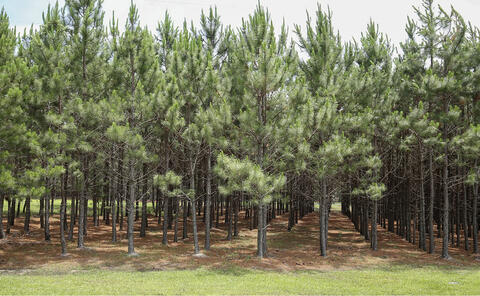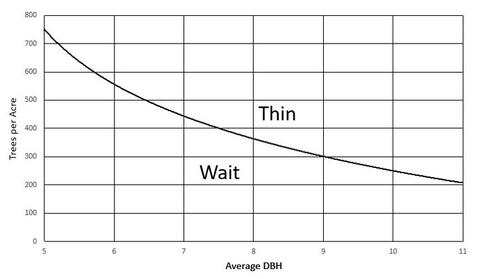P3636
Stand Density Index
Foresters often use technical language that landowners find difficult to understand. Forest owners may be familiar with basal area (the cross-sectional area of a tree at 4.5 feet aboveground) and its use as a measure of density when evaluating forest stands (if not, please read Mississippi State University Extension Publication 3590 Using the MSU Basal Area Angle Gauge). However, most are not familiar with a comparable tool called stand density index (SDI).

SDI was developed in 1933 and is the number of trees per acre at an average stand diameter of 10 inches. For familiarity, we will refer to average stand diameter as average diameter at breast height (DBH; 4.5 feet aboveground).
Overall, in theory, any pure, single-species, fully stocked, even-aged stand (all trees are close in age) of a given average DBH has approximately the same number of trees per acre as any other stand with characteristics and species at the same average DBH, regardless of stand age or site quality.
Therefore, two stands of the same species but with different densities and average diameters can be compared by finding their respective density at the average DBH of 10 inches. Comparative stand density can also be calculated by comparing a stand’s average DBH in terms of number of trees per acre (TPA) to the maximum number of trees per acre at average DBH 10 inches. While this may sound complicated, SDI graphs make the process relatively simple.
Basically, SDI has been developed using decades of research on how tree growth and survival are affected by tree-on-tree competition. It needs only the average TPA and average DBH of trees in a plantation to determine the stocking level of a particular stand. This stocking information is used to determine if a thinning operation is needed.
The general principle behind the ability of a stand to sustain trees is that, as tree size increases, the stand’s overall tree numbers must decrease. For example, at planting, a site can support several hundred seedlings per acre. However, as these trees increase in diameter and crown size, their resource needs increase.
At some point, density becomes too high to maintain high growth rates, so growth and overall stand vigor decrease. Thinning is a way to combat slower growth, maintain vigor, and increase stand value by concentrating resources on only the best trees.
Density management diagrams have been developed for the major southern pine species, but information is relatively limited for hardwood species. Learning how to use SDI and these diagrams can be valuable when managing forest stands to enhance growth and reduce risk from insects and pathogens.
MSU Extension Publication 2260 Are My Pine Trees Ready to Thin? offers a detailed process for landowners interested in using SDI in their management efforts, but the basic procedure is to inventory a stand and calculate average DBH and TPA to decide appropriateness of thinning using an SDI graph.
Figure 1 illustrates an example of an SDI graph for loblolly pine plantations. A “thinning line” is used as a recommendation for thinning. The line represents optimal stand density at a given TPA and average DBH. If the intersection of TPA and average DBH falls below the thinning line, the stand is understocked, and you should wait until the stand matures before thinning.

If the intersection of TPA and average DBH falls above the thinning line, the stand is overstocked, and you should consider thinning if the stand is biologically and commercially ready.
MSU Extension offers a smartphone app that uses SDI to help determine if it is the right time to thin pine plantations. The free app Guide to Thinning Southern Pines (Pine Thin) is available through online app stores. To learn more about this app, please read MSU Extension Publication 3664 Simplifying Southern Pine Thinning with Stand Density Index – MSUES Southern Pine Thinning: A Smartphone Application. Pine Thin provides a graph showing the density of a pine plantation using your measurements and indicates whether the stand needs thinning. The thinning line between overstocked and understocked is also provided as a target density for the residual stand that should be left after thinning.
While the concept of SDI may be somewhat confusing at first, average DBH and TPA are easy to calculate. This information may then be used to determine where your stand falls on the appropriate SDI graph. MSU Extension Publication 2260 provides a step-by-step approach to taking the necessary measurements, and Extension Publication 3664 provides a quick SDI analysis of your stand. While SDI is not the only tool available to help with thinning decisions, it can be useful and is relatively straightforward in practice.
Suggested Reading
Ashton, M. S., & Kelty, M. J. (2018). The practice of silviculture: Applied forest ecology (10th ed.). Wiley.
Reineke, L. H. (1933). Perfecting a stand density index for even-aged forest. Journal of Agricultural Research, 46, 627–638.
Self, A. B., & Floyd, J. (2018). Using the MSU basal area angle gauge. Mississippi State University Extension Information Sheet 1995.
Self, A. B. (2019). Are my pine trees ready to thin? Mississippi State University Extension Publication 2260.
Smith, D. M., Larson, B. C., Kelty, M. J., & Ashton, P. M. S. (1997). The practice of silviculture: Applied forest ecology (9th ed.). John Wiley and Sons.
Willis, J. L., & Henderson, J. E. (2016). Simplifying southern pine thinning with stand density index: Pine Thin: A smartphone application. Mississippi State University Extension Information Sheet 2010.
Publication 3636 (POD-05-24)
By Brady Self, PhD, Extension Professor, Forestry.
